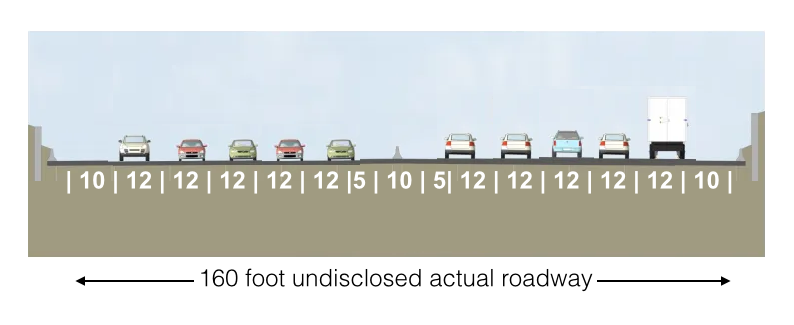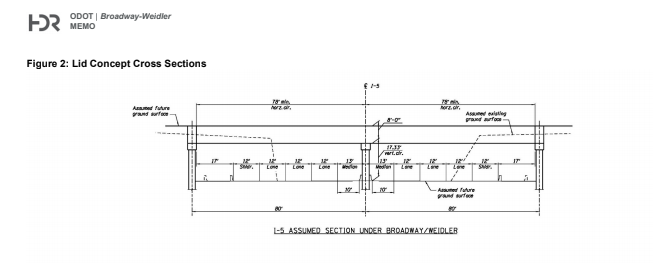For years, ODOT has been planning to build a 10 lane freeway at the Rose Quarter, not the 6 lanes it has advertised.
Three previously undisclosed files show ODOT is planning for a 160 foot wide roadway at Broadway-Weidler, more than enough for a 10 lane freeway with full urban shoulders.
ODOT has failed to analyze the traffic, environmental and health impacts from an expansion to ten lanes; not disclosing these reasonably foreseeable impacts is a violation of the National Environmental Policy Act (NEPA).
For years, the Oregon Department of Transportation has represented its plans to widen I-5 through the Rose Quarter in Portland as a minor addition of a pair of “auxiliary” lanes to the existing four lanes than carry I-5 through this area. The agency has repeatedly declined to answer direct questions about the actual physical width of the roadway it is engineering, instead it relies on an incomplete and misleading illustration published in its Environmental Assessment.
Now, No More Freeways, a Portland citizen advocacy group has obtained documents showing that ODOT is actually planning a 160 foot roadway, one more than adequate to accommodate a full ten lane freeway. A story from Willamette Week, “Questions about the footprint of the I-5 Rose Quarter project intensify“, reveals that the Oregon Department of Transportation has long concealed data on the actual width of the freeway it is planning to build through Portland’s Rose Quarter.
ODOT has previously and repeatedly refused to answer basic questions about the width of the freeway. These documents, which include detailed plans developed by ODOT and its contractors, shows the agency has long known exactly how wide a freeway it is planning, and has designed overpass structures to provide a full 160 feet of buildable space for Interstate 5 roadway at Broadway and Weidler. There’s no doubt, however, that the agency will continue to claim that it’s building a six lane freeway, but no one should believe them: there’s no reason to engineer a massive 160 foot wide roadway for only six lanes, as their own engineering documents, disclosed below show. Moreover, this kind of deception is an established pattern for ODOT; in 2010 they assured Portland Mayor Sam Adams that they were shrinking the proposed Columbia River Crossing from 12-lanes to 10; instead, they kept the proposed bridge as wide as before and simply deleted all the references to its actual physical width from final environmental documents
Misleading and incomplete information in the Environmental Assessment
The only information provided about the width of the Rose Quarter Freeway was included in a single illustration contained in the project’s 2019 Environmental Assessment. This illustration, which omits the overall width of the project shows only the dimensions of travel lanes and shoulders. Together these add up to 126 feet. That width, as we’ve pointed out at City Observatory, would easily hold an eight-lane freeway.
ODOT’s Misleading EA Illustration: Six lanes in 126 feet
The following illustrations are taken from the Rose Quarter Environmental Assessment’s Right of Way Report. We have added the black annotation with arrows indicating the width of the roadway; ODOT’s original illustrations do not provide this information, but we have calculated it from aerial imagery (existing) and by summing the lane and shoulder widths indicated on ODOT illustration (proposed).
What really fits in ODOT’s 160 foot roadway: 10 lanes of freeway
We’ve drawn a new version of ODOT’s illustration that shows the actual size of the roadway they are proposing to build (on approximately the same scale as ODOT’s illustrations -above). We’ve also shown how many lanes of traffic this roadway will accommodate. Our diagram also shows the dimensions of travel lanes, and inside and outside shoulders an allowance for the freeway median and its structures. This illustration makes it clear that ODOT is building a roadway that will easily accommodate a full ten-lane freeway.
ODOT’s actual freeway cross section at Broadway-Weidler

The undisclosed evidence of the 160 foot roadway.
Throughout the environmental review process and afterwards, the Oregon Department of Transportation has repeatedly declined to disclose the actual width, in feet, of the roadway it is planning to build through the Rose Quarter.
We’ve independently verified ODOT’s decision to engineer a 160-wide roadway based on three different documents.
File 1: HDR Cover Analysis Memorandum, 2016
In April 2016, ODOT consultants HDR prepared this memorandum to provide design parameters for the development of a proposal to construct covers over the freeway. Figure two of this diagram shows the cross section of the freeway as proposed to be built under Broadway and Weidler overpasses. The measurements on the diagram show two 80 foot spans on either side of a median support structure for a total width of 160 feet. The detailed roadway section shows six 12 foot travel lanes, four 12 foot shoulders, and two unlabeled, vacant 17′ sections on either side of the outside shoulders. The measurements on this diagram help explain the 126 foot section shown in ODOT’s illustrations above: The illustration excludes the two 17 foot sections; adding back these sections brings the right of way to its full 160 foot width (126+34=160). This detailed plan shows that actual travel lanes (36 feet; three 12 foot lanes on each side of the freeway) utilize less than half of the 80 feet of roadway under the overpass, with more space devoted to shoulders (24 feet in two shoulders) and an unlabeled 17 foot section (41 feet total).
Memo, April 7, 2016. From Andy Johnson (HDR) and Ron Hughes (AECOM), to Mike Mason and John Makler (ODOT), Subject: Broadway/Weidler Lid Structure Design Concept Feasibility Analysis.
File 2: CAD-Design Files
No More Freeways obtained a set of ODOT Computer Aided Design (CAD) files showing the plan for the proposed freeway. We opened this file in a CAD program and used the file’s internal scale tool to measure the total distance of the roadway section as it crossed under the Broadway and Weidler overpasses. The roadway section is shown in green; the total width of the roadway is 160 feet.
File 3: Landscape Plans
ODOT hired landscape architect Marianne Zarkin (as a subcontractor to Nelson Nygaard and HDR) to develop a landscape plan for a proposed freeway cover. Her firm’s website contains a plan of the proposed hardscape and landscaping for the freeway cover, and an included cross-section diagram illustrates the width of the freeway. The files are un-dated. While the diagram itself lacks a scale, it does show the size and location of freeway lanes. Based on the nominal 12′ width of these lanes, the plan shows that the Broadway-Weidler overpass would span a distance of more than 150 feet.
Editor’s Note (February 25, 2021): After this commentary was originally published, these images were removed from the publicly accessible location on Zarkin’s website. The link that directed to the image shown above now shows as “not found,” as shown below:
City Observatory retains copies downloaded from the website on 24 February 2021.
Why this matters: More traffic, more pollution, an invalid environmental assessment
ODOT has attempted to minimize the traffic, environmental, health and noise effects of its freeway widening project by representing it as the addition of only two “auxiliary” lanes to the existing four-lane freeway. These newly revealed plans show that ODOT is actually planning a ten-lane freeway, which would accommodate vastly more traffic, and as a result would have far different and much greater impacts on the area’s livability, safety, and environment.
Constructing additional lanes will induce additional traffic demand, leading to large increases in vehicle miles traveled, air pollution emissions and greenhouse gases. A ten-lane freeway will, for example, increase the air pollution exposure of students at Harriet Tubman Middle School, which abuts the widened freeway. The traffic from the ten lane freeway will flood adjacent city streets, making them more hazardous for cyclists and pedestrians. A higher level of traffic through the Rose Quarter will also make sites on or near the freeway (like the proposed caps) noisier and more polluted than revealed in the Environmental Assessment.






